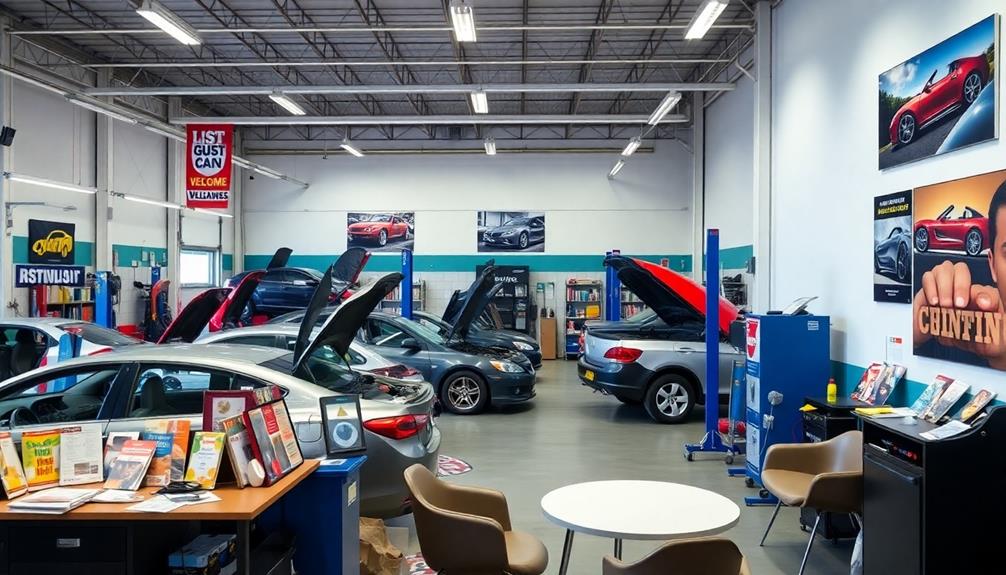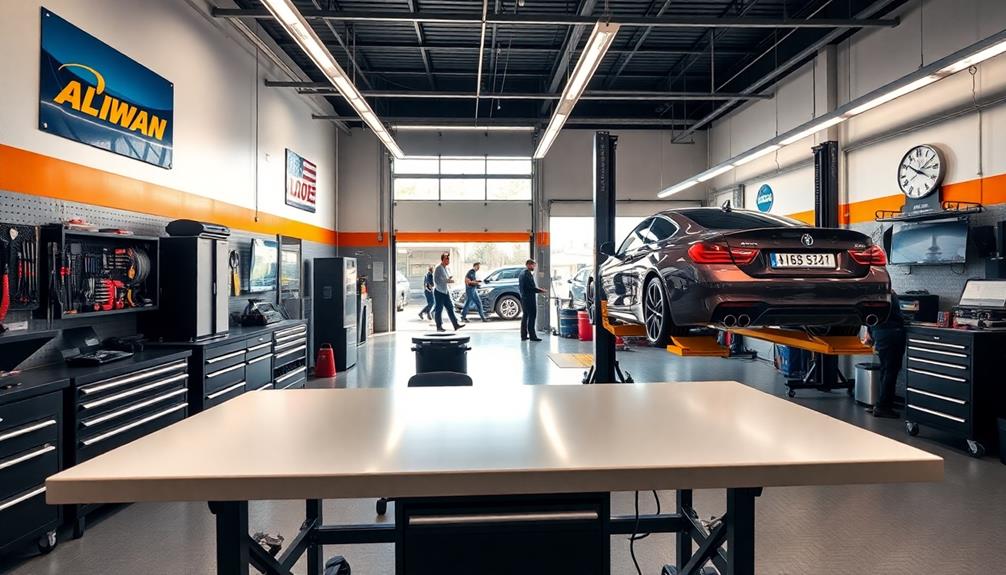To attract more customers to your automotive repair shop, consider these effective advertising ideas. Start with local SEO to improve visibility in searches, ensuring your business shows up when locals need you. Use social media to share engaging content, showcasing transformations of vehicles. Don't underestimate the power of word-of-mouth; incentivizing referrals can considerably boost client numbers. Seasonal promotions and community events can draw in foot traffic while enhancing your reputation. Finally, highlight customer testimonials to build trust. Want to explore even more innovative strategies? There's much more to discover about boosting your automotive repair advertising efforts!
Key Takeaways
- Implement local SEO strategies to enhance visibility in search results, targeting nearby customers effectively.
- Create engaging social media campaigns featuring before-and-after visuals to attract potential clients.
- Launch a referral program with incentives to encourage satisfied customers to refer new clients.
- Host community events or workshops to showcase expertise and build goodwill within the local area.
- Utilize email marketing with personalized content and compelling subject lines to boost engagement and drive traffic.
Word-of-Mouth Marketing Strategies

When it comes to attracting new customers in the automotive repair industry, word-of-mouth marketing is incredibly powerful. It accounts for about 20-50% of all purchasing decisions, showing just how effective personal recommendations can be.
You'll find that satisfied customers are four times more likely to refer your services to their friends, driving significant growth for your shop. Recognizing signs of stagnation can help you identify when customer relationships need revitalizing to keep referrals flowing.
One way to harness this power is by implementing a referral program. Offering incentives like discounts or rewards can motivate your existing customers to spread the word about your business.
Encourage them to leave positive customer reviews, as 88% of consumers trust online reviews just as much as personal recommendations.
Participating in community events also enhances your local recognition. When you engage with your community, satisfied customers are more likely to share their experiences with friends and family, creating organic word-of-mouth referrals.
Effective Digital Advertising Techniques

Harnessing the power of digital advertising can transform your automotive repair shop's visibility and customer engagement. By employing effective digital advertising techniques, you can reach potential customers where they spend most of their time—online.
Here's a quick overview of key techniques:
| Technique | Benefits |
|---|---|
| PPC Advertising | Generates an average ROI of 200% for optimized campaigns. |
| Local SEO | Enhances visibility in local searches, essential since 46% of Google searches seek local info. |
| Email Marketing | Achieves an average open rate of 18.0%, perfect for keeping in touch with customers. |
| Social Media | Reaches specific demographics; 73% of adults use platforms like Facebook. |
| Video Content | Increases engagement rates by up to 1200%, ideal for showcasing services. |
Engaging Social Media Campaigns
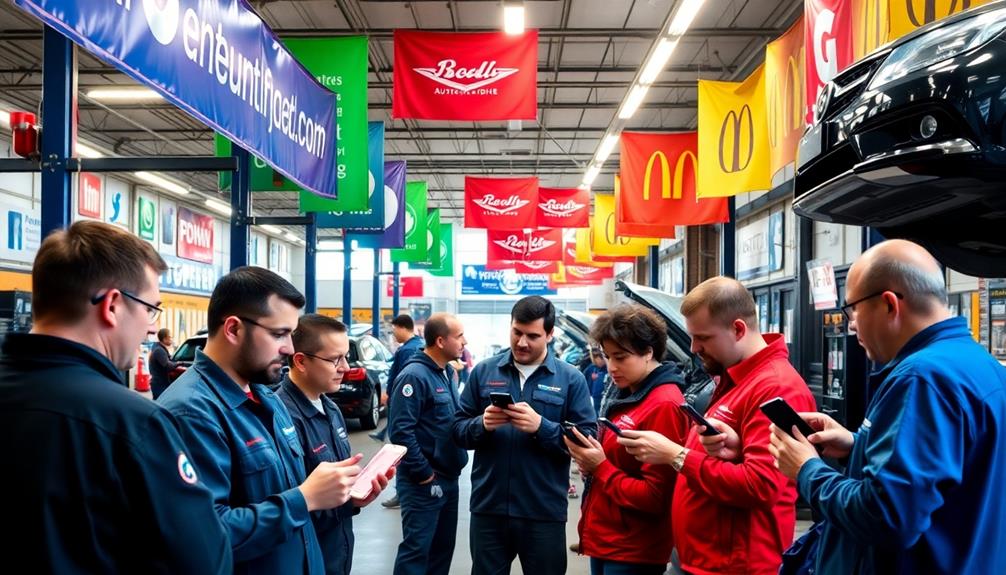
Building on effective digital strategies, engaging social media campaigns can greatly elevate your automotive repair shop's presence. With 80% of consumers more likely to interact with brands that shine online, you can enhance customer loyalty and trust through your social media efforts.
Utilize platforms like Instagram, where 73% of American adults hang out, to showcase fascinating before-and-after visuals of automotive repairs. These appealing images can draw in potential customers and encourage them to think about their own budget for necessary repairs.
Incorporating interactive posts, such as polls or quizzes about car maintenance, can boost engagement rates by up to 20% and create a sense of community among your followers. People love to share their opinions and learn something new!
Additionally, sharing video content like tutorials or customer testimonials is essential, as 54% of consumers prefer video over other content types.
Don't forget the power of targeted Facebook ads. With 78% of marketers seeing positive results from social media advertising, you can effectively reach specific demographics and drive traffic to your shop.
Combine these tactics into your content marketing strategy, and you'll see increased engagement and a stronger online presence for your automotive repair business.
Customer Loyalty Programs

Customer loyalty programs can be a game changer for your automotive repair business.
By offering incentives for repeat visits and creating personalized follow-up strategies, you'll keep customers coming back for more.
Plus, with a clear reward structure and benefits, you'll not only boost satisfaction but also strengthen brand loyalty.
Incentives for Repeat Visits
A well-structured loyalty program can considerably boost customer retention for your automotive repair business. By implementing incentives for repeat visits, you not only keep your current customers engaged but also encourage them to refer new clients. Consider incorporating a tiered membership system with exclusive rewards to make your program more appealing.
Here's a simple framework for your loyalty program:
| Tier Level | Points Required | Exclusive Rewards |
|---|---|---|
| Bronze | 0-499 | Basic discounts on services |
| Silver | 500-999 | Free oil change and referral bonuses |
| Gold | 1000+ | Priority service and exclusive events |
| Platinum | 1500+ | Free annual vehicle inspection |
| Diamond | 2000+ | Personalized service and gifts |
Encourage customers to provide feedback on the program to keep it fresh and relevant. Regularly updating perks based on their input can greatly enhance customer retention. Remember, loyal customers contribute greatly to your revenue. With the right incentives, you can create a thriving community of repeat patrons.
Personalized Follow-Up Strategies
Effectively engaging with your customers after their visits can greatly enhance their loyalty and satisfaction. By implementing personalized follow-up strategies, you can keep your shop top-of-mind and markedly boost customer retention rates. For instance, sending tailored service reminders helps guarantee customers return for essential maintenance, increasing their likelihood of coming back.
Additionally, utilizing data-driven marketing strategies allows you to understand customer preferences better, enhancing the effectiveness of your follow-up communications.
Loyalty programs are another powerful tool. When you reward customers with points for each visit, you encourage repeat services, which can lead to a 12-18% increase in annual revenue. Engaging customers through follow-ups often results in a 30% higher customer satisfaction rate, reinforcing trust and prompting referrals.
Don't underestimate the impact of exclusive discounts or rewards for repeat visits. Offering these incentives can motivate around 80% of customers to engage with your loyalty program, enhancing their overall experience.
Additionally, consider using segmented email campaigns to provide tailored offers based on individual customer preferences. This approach can achieve open rates of up to 29%, making your follow-up communications much more effective.
Reward Structures and Benefits
Implementing a loyalty program can greatly boost your automotive repair shop's success by enhancing customer retention and engagement. Loyal customers contribute markedly to your revenue, with studies showing they can account for 12-18% annually.
By offering tiered membership levels, you create opportunities for repeat visits, which can lead to exclusive rewards that keep customers coming back.
To maximize the effectiveness of your loyalty program, consider these strategies:
- Referral bonuses: Encourage your loyal customers to bring in new clients by rewarding them for referrals.
- Personalized rewards: Tailor rewards based on individual customer preferences, enhancing their experience and satisfaction.
- Customer engagement initiatives: Foster a sense of community among your loyal customers, making them feel valued and connected to your brand.
With about 80% of consumers participating in at least one loyalty program, establishing one for your shop can attract and retain customers.
Utilizing Local SEO

Local SEO is vital for automotive repair shops looking to attract nearby customers. With 46% of all Google searches focused on local information, optimizing your Google Business Profile is key to improving visibility in local search results.
Make certain your shop's NAP (Name, Address, Phone) is accurate across all online listings. This consistency boosts your search engine ranking and helps potential customers find and contact you easily.
Incorporating local keywords—like your city name or neighborhood—into your website content and meta tags can greatly enhance your local search presence. Remember, 78% of mobile local searches lead to offline purchases, so a strong local SEO strategy is critical for converting that online interest into in-store visits.
Regularly updating your online listings and engaging with customer reviews on platforms like Google and Yelp not only improves your shop's credibility but also influences local search rankings.
Email Marketing Best Practices
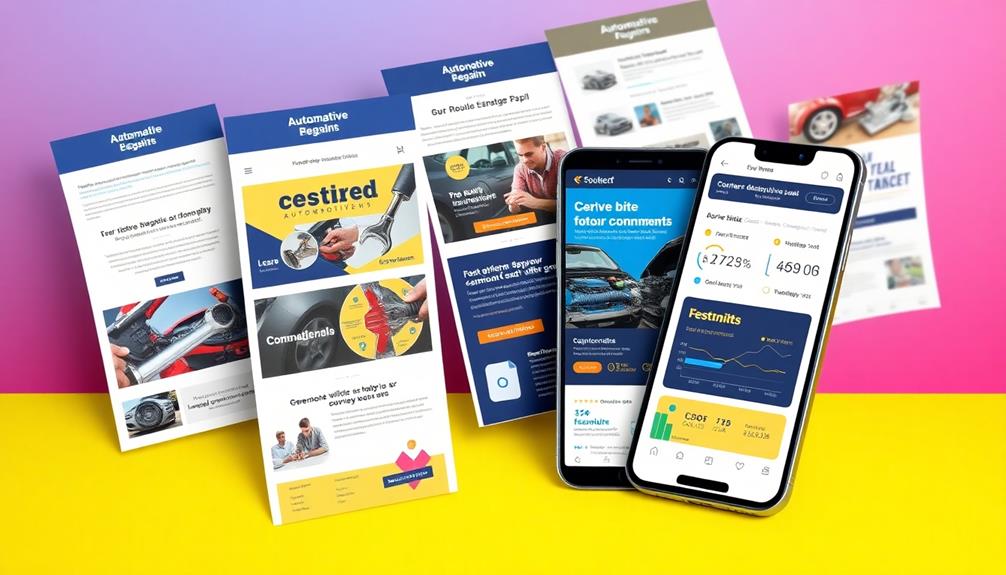
When it comes to email marketing, personalization is key to boosting open rates and driving revenue.
Engaging subject lines can grab attention and encourage customers to open your emails, while analyzing open rates helps you refine your strategy for even better results.
Personalization In Email Campaigns
Frequently, businesses overlook the power of personalization in email campaigns, which can greatly enhance customer engagement. By focusing on personalized emails, you can substantially improve your click-through and conversion rates.
For instance, segmenting email lists based on customer behavior and preferences allows for targeted messaging that resonates with your audience.
Consider these effective strategies:
- Use recipients' names in the subject lines to increase open rates—it's proven to boost engagement by 26%.
- Send tailored content, such as service reminders or maintenance tips specific to the vehicle types owned by your customers, enhancing the perceived value of your communication.
- Implement A/B testing to discover which personalized elements work best, ensuring you maximize engagement and response rates.
When you incorporate these tactics, you not only build stronger connections with your customers but also drive loyalty and satisfaction.
Personalized emails create a more relatable experience, making your audience feel valued and understood. By leveraging segmentation and tailored content, your email campaigns will stand out in crowded inboxes, ultimately leading to higher success rates.
Engaging Subject Lines
Crafting engaging subject lines is essential for capturing your audience's attention and driving email open rates. To enhance your automotive repair advertising, consider incorporating personalized elements like the recipient's name. This simple tweak can boost open rates by up to 26%.
Urgency is another powerful tool; using phrases like "Last Chance for 20% Off Your Next Service!" can lead to a 22% increase in engagement.
You might also try posing questions in your subject lines, such as "Is Your Vehicle Ready for Winter?" This strategy can spark curiosity and improve open rates by 10-15%.
Another effective approach is to include numbers or lists, like "5 Essential Tips for Winterizing Your Car." This tactic can increase open rates by a whopping 36%.
Analyzing Open Rates
Understanding how to analyze open rates is essential for optimizing your automotive email marketing campaigns. By keeping an eye on these metrics, you can enhance customer engagement and drive better results. The average open rate for automotive emails hovers around 20-25%, but with a few strategic tweaks, you can boost those numbers considerably.
- Personalize your subject lines, as they can increase open rates by 26%.
- Incorporate a compelling call-to-action (CTA) in your subject line, which can raise open rates by 50%.
- Utilize A/B testing to discover which subject lines resonate best with your audience.
Also, consider the timing of your emails. Sending them on Tuesdays or Thursdays can improve open rates, with Tuesday often seeing 20% higher engagement.
Segmenting your email list based on customer behavior and preferences can further enhance your open rates, making your automotive email campaigns more effective.
Seasonal Promotions and Events
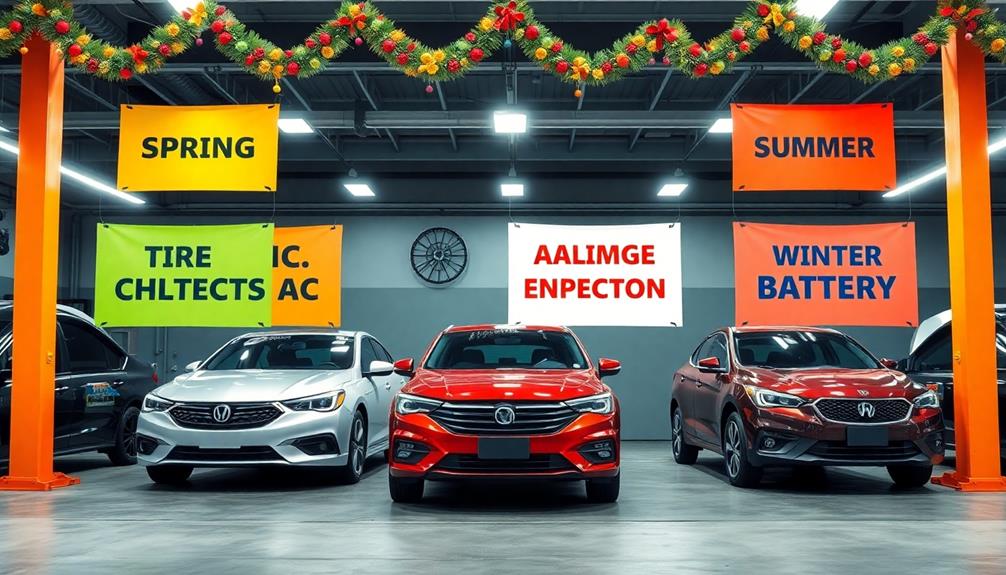
Leveraging seasonal promotions and events can considerably boost your automotive repair business. By addressing specific vehicle maintenance needs tied to weather changes, you can attract new customers. For instance, summer tire checks or winter readiness packages are great options. Offering limited-time discounts, like 15% off services in the spring, creates urgency and encourages immediate bookings.
Hosting community events, such as fall car maintenance workshops, helps you engage with local residents while showcasing your expertise. Tailoring marketing campaigns around holidays, like Father's Day car care packages, resonates with customers searching for gift ideas.
Here's a quick reference table to guide your seasonal promotions:
| Season | Promotion Idea |
|---|---|
| Spring | 15% off service packages |
| Summer | Free tire checks |
| Fall | Car maintenance workshop |
| Winter | Winter readiness package discounts |
Utilizing direct mail postcards with seasonal service reminders can yield a high ROI. Remember, targeted campaigns can generate significant revenue—one successful postcard effort can bring in $14,400. So, plan your seasonal promotions and leverage these strategies to maximize your impact!
Community Engagement Initiatives
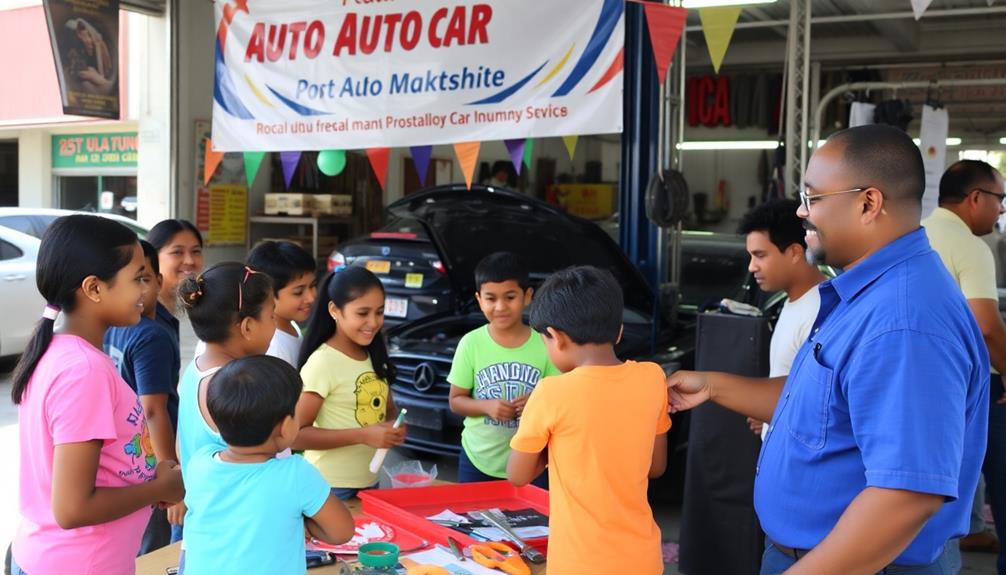
Engaging with your community through local event sponsorships and charity drives can considerably boost your brand's reputation.
Hosting workshops and clinics not only showcases your expertise but also attracts potential customers enthusiastic for free services.
Local Event Sponsorships
How can sponsoring local events elevate your automotive repair shop's presence in the community? By engaging in local event sponsorships, you can greatly boost your brand visibility and connect with potential customers. When you align your shop with community events, you not only enhance your reputation but also create a sense of goodwill among residents.
Consider these benefits:
- Position yourself as a trusted authority: Hosting free car maintenance workshops at local events showcases your expertise and builds trust with attendees.
- Attract new clientele: Offering discounts or promotional items during these events can entice 79% of consumers to take action, drawing them to your shop.
- Collaborate with local businesses: Joint sponsorships can expand your reach, increase customer engagement, and drive higher attendance at events, benefiting everyone involved.
Sponsoring community events demonstrates your commitment to charitable causes and reinforces the idea that businesses should support their local communities.
With 70% of consumers preferring brands that engage locally, this strategy not only boosts visibility but also fosters lasting relationships with your audience.
Charity Drives Participation
By participating in charity drives, your automotive repair shop can greatly boost community engagement and strengthen your brand's reputation. Engaging in local charity events not only enhances brand visibility but also builds trust with customers—88% of consumers prefer businesses that support charitable causes.
Collaborating with local nonprofits for initiatives like car washes or donation drives creates meaningful marketing opportunities while attracting new customers.
These charity events can considerably increase customer loyalty, with 71% of consumers more likely to recommend a business involved in community service.
Plus, documenting the impact of your charity initiatives on social media can further enhance customer engagement. In fact, 79% of consumers are more inclined to support brands that showcase community involvement.
Workshops and Clinics
Building on the strong community ties established through charity drives, hosting workshops and clinics can further enhance your automotive repair shop's presence in the local area.
By offering educational workshops on basic vehicle maintenance, you can attract up to 30% more local attendees, providing excellent opportunities for customer engagement.
Consider these strategies to maximize impact:
- Host free clinics for specific services like tire rotations or oil changes to boost foot traffic and increase service bookings.
- Collaborate with local schools or organizations to position your shop as a trusted community resource, fostering positive word-of-mouth referrals.
- Utilize social media to promote upcoming workshops, which can increase event attendance by 40% through platforms like Facebook and Instagram.
Community engagement through these initiatives not only enhances brand loyalty—70% of participants are likely to return for services—but also solidifies your shop's role as an essential part of the local landscape.
Leveraging Customer Testimonials

Harnessing the power of customer testimonials can greatly enhance your automotive repair business's credibility and attract new clients. Did you know that 79% of consumers trust online reviews as much as personal recommendations? By prominently featuring these customer testimonials on your website and social media, you can increase visibility and potentially boost conversion rates by up to 270%.
Video testimonials are particularly effective, with 64% of consumers more likely to engage after watching a video showcasing real customer experiences. Encourage satisfied customers to leave reviews on platforms like Google and Yelp; 85% of consumers read online reviews before making a decision, so this can remarkably boost your online reputation.
Incorporating testimonials into targeted email marketing campaigns can also lead to higher engagement rates. Personalized emails enjoy an average open rate of 18.8%, compared to just 13.1% for non-personalized ones.
Analyzing Marketing Performance
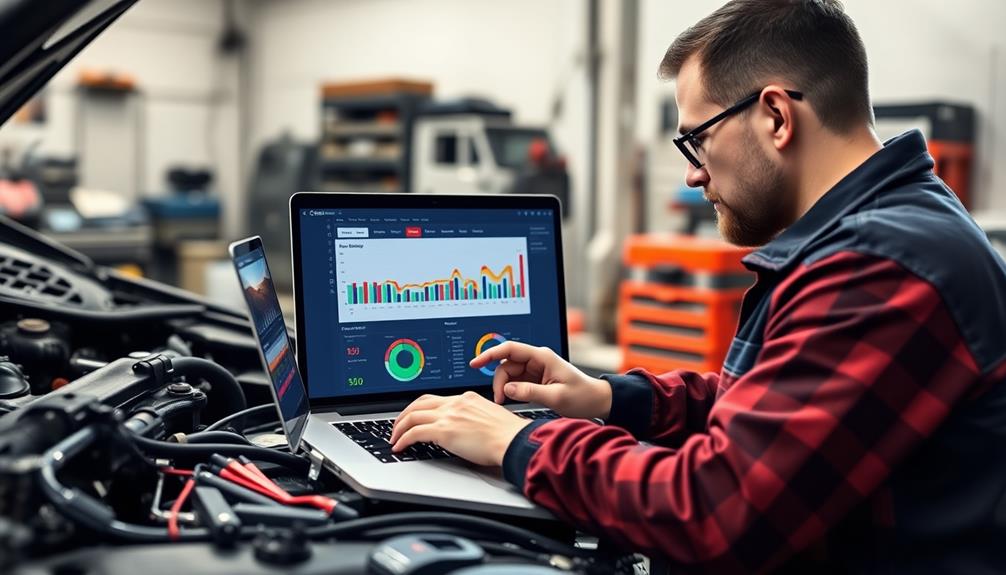
Analyzing marketing performance is essential for any automotive repair business aiming to thrive in a competitive landscape. By regularly evaluating your marketing strategies, you can identify successful campaigns and make necessary adjustments to underperforming ones.
Data analytics plays a significant role in this process, revealing where your customers come from and which channels generate the most traffic and revenue.
To effectively analyze your marketing performance, focus on these key areas:
- Track customer acquisition sources to understand effective channels.
- Measure return on investment (ROI) to evaluate the cost-effectiveness of your campaigns.
- Monitor customer retention rates to gauge long-term loyalty and satisfaction.
Frequently Asked Questions
How Do You Attract Customers to Auto Repair?
To attract customers, you can leverage word-of-mouth referrals, host engaging community events, utilize targeted email campaigns, maintain an active social media presence, and create urgency with seasonal promotions. These strategies will boost your customer base effectively.
How Do I Advertise My Repair Business?
To advertise your repair business, leverage targeted email campaigns, optimize your online presence, engage on social media, create valuable content, and implement a referral program. These strategies'll help you reach more potential customers effectively.
How Do I Advertise for a Mechanic?
Market your mechanic shop by mastering mobile-friendly media, maximizing social platforms, and showcasing stellar service. Get involved in local events, encourage enthusiastic endorsements, and optimize your online presence to attract attentive, new customers consistently.
How Do I Get Customers for My Auto Repair Shop?
To get customers for your auto repair shop, implement a referral program, engage with your community, optimize your online presence, and utilize social media. These strategies build trust and attract new clients effectively.
Conclusion
Incorporating these automotive repair advertising ideas can skyrocket your business to new heights! By embracing word-of-mouth strategies, effective digital ads, and engaging social media campaigns, you'll create a buzz that's impossible to ignore. Don't forget to leverage customer loyalty programs and local SEO to draw in more clients. By actively engaging with your community and showcasing testimonials, you'll build trust and credibility. With the right approach, your repair shop could become the talk of the town! Additionally, offering free inspections or discounted services can entice new customers while keeping your current ones satisfied. When crafting a **good name for an auto repair** business, make sure it reflects quality, trust, and reliability—essential values that will resonate with clients. By combining these tactics, you’ll position your shop as the go-to destination for automotive care in your area.
